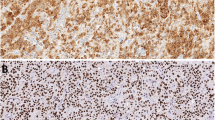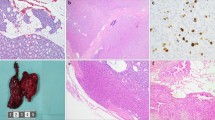Abstract
The diagnosis of parathyroid carcinoma can be challenging, and adjuvant therapies such as radiotherapy and chemotherapy are not particularly beneficial in the management of this disease, creating a challenge when dealing with unresectable recurrent and metastatic malignancy. We investigated the expression profile of biomarkers that represent potential markers of malignancy or targets for novel therapies in this disease. We constructed a tissue microarray of parathyroid carcinomas from 10 patients as well as parathyroid adenomas from 25 patients and stained the slides for 34 proteins involved in angiogenesis (platelet-derived growth factor receptor (PDGFR)-α, PDGFR-β, vascular endothelial growth factor receptor-2 (VEGFR-2), and epidermal growth factor receptor (EGFR)), inflammation (cyclooxygenase (COX)-1 and COX-2), cell adhesion (matrix metalloproteinase (MMP)-1, CD9, and keratin 7), cell cycle (Cdc2p34, cyclin D1, retinoblastoma (Rb), p27, p21, parafibromin, Bmi-1, 14-3-3σ, and p53), and apoptosis (Bcl-2a, Mcl-1, Bcl-xL, and glutathione-S-transferase-isoenzyme π (Gst-π)) along with some markers of the sonic hedgehog (Smo, SHH, Gli-1, Gli-2, Gli-3, and patched), mTOR (AKT, mammalian target of rapamycin (mTOR), and Forkhead box O (FoxO)-1), and WNT (Wisp-1, Wisp-2, and β-catenin) signal transduction pathways. Protein expression was determined using computerized image analysis software (Spectrum Plus©, Aperio). Bcl-2a, parafibromin, Rb, and p27 were significantly decreased to variable degrees in all parathyroid carcinomas. COX-1/2, CD9, MMP-1, FoxO-1, VEGFR-2, PDGFR-α/β, Gst-π, Gli-1, Gli-2, Gli-3, and patched were expressed in the majority of benign and malignant tumor cells. These results indicate that the use of a panel that includes Bcl-2a, parafibromin, Rb, and p27 may be helpful in the assessment of atypical parathyroid neoplasms. Although the majority of other markers studied are also expressed in both benign and malignant parathyroid neoplasms, we have identified several potentially important target proteins related to angiogenesis and cell proliferation along with COX-1/2, Gst-π and members of sonic hedgehog pathway that may be therapeutic targets in parathyroid carcinoma. While these results are preliminary, a successful outcome of a clinical trial directed against these novel targets would provide much needed systemic adjuvant treatment for patients with metastatic parathyroid carcinoma.



Similar content being viewed by others
References
Hundahl SA, Fleming ID, Fremgen AM, Menck HR (1999) Two hundred eighty-six cases of parathyroid carcinoma treated in the U.S. between 1985 and 1995: a National Cancer Data Base Report. The American College of Surgeons Commission on Cancer and the American Cancer Society. Cancer 86:538–544.
Erovic BM, Goldstein DP, Kim D, Mete O, Brierly J, Tsang R, Freeman JL, Asa SL, Rotstein L, Irish JC (2012). Parathyroid cancer: outcome analysis of 16 patients treated at the Princess Margaret Hospital. Head Neck 2012, doi:10.1002/hed.22908.
Lee PK, Jarosek SL, Virnig BA, Evasovich M, Tuttle TM (2007) Trends in the incidence and treatment of parathyroid cancer in the United States. Cancer 109:1736–1741.
Sandelin K, Auer G, Bondeson L, Grimelius L, Farnebo LO (1992) Prognostic factors in parathyroid cancer: a review of 95 cases. World J Surg 16:724–731.
Chow E, Tsang RW, Brierley JD, Filice S (1998) Parathyroid carcinoma—the Princess Margaret Hospital experience. Int J Radiat Oncol Biol Phys 41:569–572.
Munson ND, Foote RL, Northcutt RC, Tiegs RD, Fitzpatrick LA, Grant CS, van Heerden JA, Thompson GB, Lloyd RV (2003) Parathyroid carcinoma: is there a role for adjuvant radiation therapy? Cancer 98:2378–2384.
Betea D, Bradwell AR, Harvey TC, Mead GP, Schmidt-Gayk H, Ghaye B, Daly AF, Beckers A. (2004) Hormonal and biochemical normalization and tumor shrinkage induced by anti-parathyroid hormone immunotherapy in a patient with metastatic parathyroid carcinoma. J Clin Endocrinol Metab 89:3413–3420.
Schott M, Feldkamp J, Schattenberg D, Krueger T, Dotzenrath C, Seissler J, Scherbaum WA (2000) Induction of cellular immunity in a parathyroid carcinoma treated with tumor lysate-pulsed dendritic cells. Eur J Endocrinol 142:300–306.
Schott M, Feldkamp J, Schattenberg D, Seissler J, Scherbaum WA (1999) Dendritic cell immuno-therapy in disseminated parathyroid carcinoma. Lancet 353:1188–1189.
Mete O, Asa SL (2011) Pathological definition and clinical significance of vascular invasion in thyroid carcinomas derived from follicular epithelium. Modern Pathology 24:1545–1552.
Machiels JP, Schmitz S (2011) Molecular-targeted therapy of head and neck squamous cell carcinoma: beyond cetuximab-based therapy. Curr Opin Oncol 23:241–248.
Cataldo VD, Gibbons DL, Pérez-Soler R, Quintás-Cardama A (2011) Treatment of non-small-cell lung cancer with erlotinib or gefitinib. N Engl J Med 364:947–955.
Chee CE, Sinicrope FA (2010) Targeted therapeutic agents for colorectal cancer. Gastroenterol Clin North Am 39:601–613.
Hsu JY, Wakelee HA (2009) Monoclonal antibodies targeting vascular endothelial growth factor: current status and future challenges in cancer therapy. BioDrugs 23:289–304.
Chow LQ, Eckhardt SG (2007) Sunitinib: from rational design to clinical efficacy. J Clin Oncol 25:884–896.
Bukowski RM (2010) Pazopanib: a multikinase inhibitor with activity in advanced renal cell carcinoma. Expert Rev Anticancer Ther 10:635–645.
Perrone MG, Scilimati A, Simone L, Vitale P (2010) Selective COX-1 inhibition: a therapeutic target to be reconsidered. Curr Med Chem 17:3769–805.
Kao J, Sikora AT, Fu S (2009). Dual EGFR and COX-2 inhibition as a novel approach to targeting head and neck squamous cell carcinoma. Curr Cancer Drug Targets 9:931–937.
Moreira L, Castells A (2010). Cyclooxygenase as a target for colorectal cancer chemoprevention. Curr Drug Targets 12:1888–1894.
Peukert S, Miller-Moslin K (2010) Small-molecule inhibitors of the hedgehog signaling pathway as cancer therapeutics. Chem Med Chem 5:500–512.
Narita S, So A, Ettinger S, Hayashi N, Muramaki M, Fazli L, Kim Y, Gleave ME (2008) GLI2 knockdown using an antisense oligonucleotide induces apoptosis and chemosensitizes cells to paclitaxel in androgen-independent prostate cancer. Clin Cancer Res 14:5769–5777.
Hegde GV, Munger CM, Emanuel K, Joshi AD, Greiner TC, Weisenburger DD, Vose JM, Joshi SS (2008) Targeting of sonic hedgehog-GLI signaling: a potential strategy to improve therapy for mantle cell lymphoma. Mol Cancer Ther 7:1450–1460.
Fu Z, Tindall DJ. FOXOs, cancer and regulation of apoptosis (2008) Oncogene 27:2312–2319.
Reagan-Shaw S, Ahmad N. The role of Forkhead-box Class O (FoxO) transcription factors in cancer: a target for the management of cancer (2007) Toxicol Appl Pharmacol 224:360–368.
Erovic BM, Pammer J, Hollemann D, Woegerbauer M, Geleff S, Fischer MB, Burian M, Frommlet F, Neuchrist C (2003) Motility-related protein-1/CD9 expression in head and neck squamous cell carcinoma. Head Neck 25:848–857.
Kohmo S, Kijima T, Otani Y, Mori M, Minami T, Takahashi R, Nagatomo I, Takeda Y, Kida H, Goya S, Yoshida M, Kumagai T, Tachibana I, Yokota S, Kawase I (2010) Cell surface tetraspanin CD9 mediates chemoresistance in small cell lung cancer. Cancer Res 70:8025–8035.
Takino T, Saeki H, Miyamori H, Kudo T, Sato H (2007) Inhibition of membrane-type 1 matrix metalloproteinase at cell-matrix adhesions. Cancer Res 67:11621–11629.
Thévenin AF, Zony CL, Bahnson BJ, Colman RF (2011) GST pi modulates JNK activity through a direct interaction with JNK substrate, ATF2. Protein Sci 20:834–848.
Edelman MJ (2006) Novel cytotoxic agents for non-small cell lung cancer. J Thorac Oncol 1:752–755.
Singh S, Okamura T, Ali-Osman F (2010) Serine phosphorylation of glutathione S-transferase P1 (GSTP1) by PKCα enhances GSTP1-dependent cisplatin metabolism and resistance in human glioma cells. Biochem Pharmacol 80:1343–1355.
Shattuck TM, Välimäki S, Obara T, Gaz RD, Clark OH, Shoback D, Wierman ME, Tojo K, Robbins CM, Carpten JD, Farnebo LO, Larsson C, Arnold A (2003) Somatic and germ-line mutations of the HRPT2 gene in sporadic parathyroid carcinoma. N Engl J Med 349:1722–1729.
Cryns VL, Rubio MP, Thor AD, Louis DN, Arnold A (1994) p53 abnormalities in human parathyroid carcinoma. J Clin Endocrinol Metab 78:1320–1324.
Cryns VL, Thor A, Xu HJ, Hu SX, Wierman ME, Vickery AL Jr, Benedict WF, Arnold A (1994) Loss of the retinoblastoma tumor-suppressor gene in parathyroid carcinoma. N Engl J Med 330:757–761.
Gill AJ, Clarkson A, Gimm O, et al. (2006) Loss of nuclear expression of parafibromin distinguishes parathyroid carcinomas and hyperparathyroidism-jaw tumor (HPT-JT) syndrome-related adenomas from sporadic parathyroid adenomas and hyperplasias. Am J Surg Pathol 30:1140–1149.
Krebs LJ, Shattuck TM, Arnold A (2005) HRPT2 mutational analysis of typical sporadic parathyroid adenomas. J Clin Endocrinol Metab 90:5015–5017.
Erickson LA, Jin L, Wollan P, Thompson GB, van Heerden JA, Lloyd RV (1999). Parathyroid hyperplasia, adenomas, and carcinomas: differential expression of p27Kip1 protein. Am J Surg Pathol 23:288–295.
DeLellis RA, Lloyd RV, Heitz PU, editors (2004) World Health Organization Classification of Tumours. Pathology and genetics of tumours of endocrine organs. IARC Press, Lyon.
Acknowledgments
The preliminary results of this paper were presented in part at the 101st United States and Canadian Academy of Pathology Annual Meeting, 17–23 March 2012, Vancouver, BC, Canada.
Author information
Authors and Affiliations
Corresponding author
Rights and permissions
About this article
Cite this article
Erovic, B.M., Harris, L., Jamali, M. et al. Biomarkers of Parathyroid Carcinoma. Endocr Pathol 23, 221–231 (2012). https://doi.org/10.1007/s12022-012-9222-y
Published:
Issue Date:
DOI: https://doi.org/10.1007/s12022-012-9222-y




